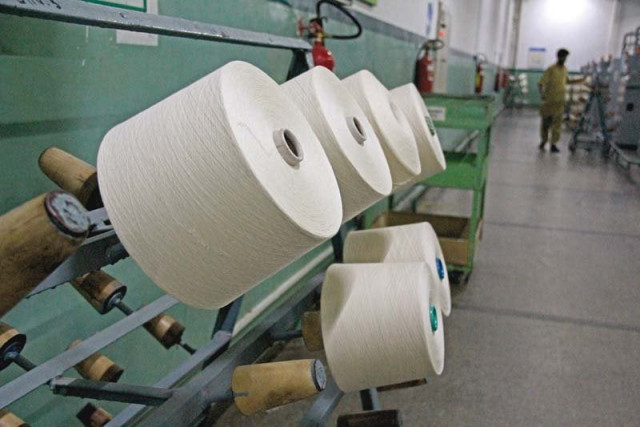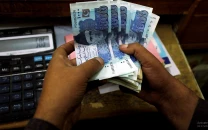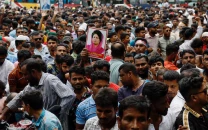Textile sector: Stitching excuses for poor growth
Sector not happy with budget announcement, wants more

The textile sector continues to be hit by the energy crisis and security concerns, but to say the budget did not favour them is definitely up for debate. PHOTO: AYESHA MIR/EXPRESS
The textile sector is probably the most vocal of them all. From gas supply issues to stuck up refunds with the Federal Board of Revenue, the sector continues to make noise and keeps stressing how it generates revenue and employment opportunities for the economy.
It was no surprise when the textile fraternity started with their recommendations for the budget and piled on the pressure.
But, even after the budget announcement where the government somewhat favoured textiles, the sector continued to lament, saying that Finance Minister Ishaq Dar has poured cold water on “high expectations” it had from the government. It argues that no “significant relief” was offered.
Using its card of being a critical sector for growth in the country, the textile industry has continued to cry over energy shortages and security concerns in the country. No one denies that those problems exist and still persist.
Due to its size in the economy, textile has been hit pretty badly.
Despite all these hurdles that have virtually stopped the industrial wheel, it is equally true that there are some that rely – a bit overly – on government support and incentives to perform well.
A large number of experts believe the textile sector is one of those sectors that excessively seek government aid.
Similarly, there are some who say that the industry has gained a lot in the budget announcement.
“The budget 2015-16 is a big positive for the textile sector,” Emerging Economics Research Managing Director Muzammil Aslam said. “The reason why leading textile associations are not happy is, perhaps, because if they say it’s all good, it may put a full stop on government incentives that are coming their way.”
These are strong words and convey a lot about how businesses think and operate.
Some of the incentives
Reduction in export refinance rate to 4.5% and bringing long-term financing to 6% -- the most reasonable rates in the history of the country – are some of the few, but huge, incentives that the government has announced for the manufacturing sector, Aslam added.
In the last budget, the government had reduced mark-up rate on exports finance from 9.4% to 7.5%. This rate was then brought down to 6% in February 2015 and has now come down to 4.5%. Similarly, the government reduced the mark-up rate on long-term financing facility, between three to 10 years, from 11.4% to 9% to allow export-oriented industries to make investments on a competitive basis. This was then reduced to 7.5% in February and has now been brought down to 6%.
However, Aslam said one of the major issues facing the export-oriented textile industry was the blockage of refunds by the FBR. This problem is also going to be solved by August 31, 2015 as per the latest commitment of the government in the budget announcement.
Exports data
An analysis of export figures also reveals a not-so-rosy picture. In the first 10 months of fiscal year 2015, overall textile exports were recorded at $11.28 billion, down 1.2% compared to the same period of previous year.
This comes despite Pakistan securing the Generalised System of Preferences (GSP) Plus facility that granted it duty-free access to markets in the European Union (EU) in December 2013, which helped the country earn more than a billion dollars in additional exports in the first 12 months.
However, analysts say that the positive impact was off-set by the euro’s depreciation, which lost about 20% of its value against Pakistani rupee in the last one year.
Commenting on the current conditions of the textile industry, renowned businessperson Zubair Motiwala put most of the blame on the rising cost of doing business.
“Textile companies are not even sustaining their businesses, how can they grow in the current environment?” he said, when asked why the textile sector is continuously failing in producing value-added products.
The budget 2015-16 will not be able to resolve the major issues of the textile sector, he said.
“We have told the government to hire an international agency to do a comparative analysis of the cost of textile industry inputs in Pakistan, India and Bangladesh – the three main competitors in textile after China.
“This will authenticate our claim that the cost of manufacturing is much higher in Pakistan compared to our competitors.”
The writer is a staff correspondent
Published in The Express Tribune, June 15th, 2015.
Like Business on Facebook, follow @TribuneBiz on Twitter to stay informed and join in the conversation.




1728020501-0/Express-Tribune-Web-(13)1728020501-0-208x130.webp)






1726134115-0/BeFunk_-(41)1726134115-0-208x130.webp)







COMMENTS
Comments are moderated and generally will be posted if they are on-topic and not abusive.
For more information, please see our Comments FAQ